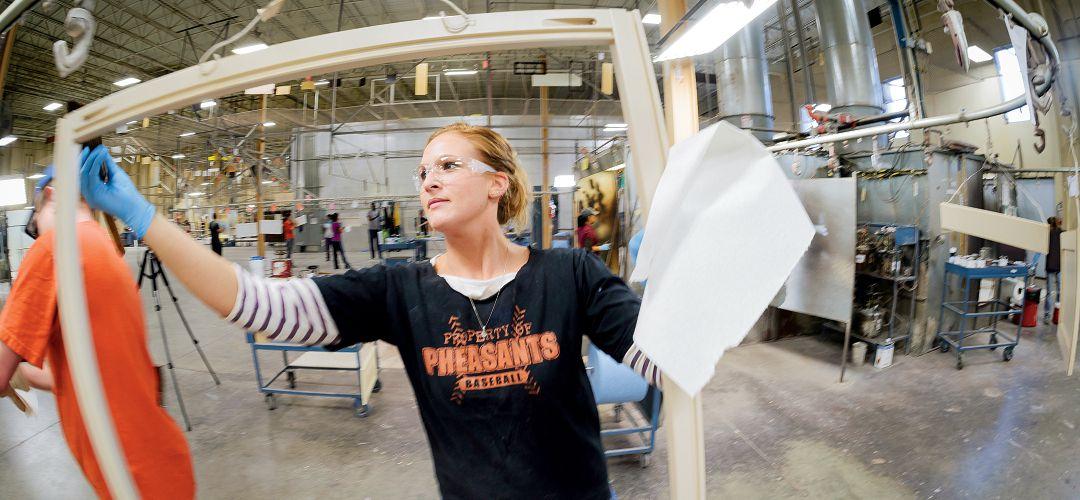
5 minute read
Show and Tell
Tour helps manufac turers highlight workforce woes, oppor tunities for educators
BY ROB SWENSON
In 15 years, South Dakota’s Show place Wood Products has grown from an ambitious vision among friends into a prominent national brand of cabinetr y. The company ’ s manufacturing plant on the north edge of Harrisburg, just a couple miles south of Sioux Falls, employs about 400 people and produces more than 500 cabinets a day. Fifty other employees are stationed elsewhere around the United States
The employee-owned company, which has more than 900 dealers, would like to keep growing
“We’re looking to expand,” says Paul Sova, president and CEO of Showplace But finding enough good workers threatens to be a major challenge, he adds
A new factory, which would be located across the street from the existing Showplace plant, is planned However, Sova and other company leaders, like executives in other manufacturing and construction businesses, are worried about the limited supply of workers in the area.
Showplace was one of four stops on a recent tour hosted by South Dakota Manufacturing and Technology Solutions, a nonprofit office in Sioux Falls that operates under the Small Business Development Center at the University of South Dakota
• Raven Industries Inc in Sioux Falls
• A Journey Group construction job site in Sioux Falls
• DeGeest Steel Works in Tea
Executives with all four companies expressed concern about the area being able to attract and retain enough workers to help businesses grow and prosper
“There are a lot of businesses in South Dakota that would like to expand,” says Jan Matthiesen, vice president of human resources at Raven Industries “It’s going to take a village to solve our workforce needs ”
Raven is a publicly traded company. It is widely known for making large balloons for some of the largest parades, festivals and entertainment parks in the world. But the manufacturer also makes electronicpositioning and information-management products, high-performance plastics films and sheeting, and other high-tech products
Peg Canter, a senior recruiter at Raven, says hiring challenges are nearing crisis levels, partly because of the low unemployment rate in the Sioux Falls area
The unemployment rate in the four-county Sioux Falls metropolitan area was 2 9 percent in August
Approximately 400 people currently work at Harrisburg, S D -based cabinet manufacturer Showplace Wood Products. The company wants to expand but leaders are concerned workers will not be available
PHOTO: CHAD COPPESS
The Workforce and Career Exploration Tour was designed to expose counselors and principals at middle schools and high schools in the Sioux Falls area to opportunities for good jobs that exist in the local manufacturing and construction sectors. About 45 educators attended the tour.
In addition to Showplace, stops on the daylong educational tour of businesses in Sioux Falls and other communities included:
Another problem is that high school students feel pressured to attend four-year colleges rather than explore technical job opportunities that require less education, Canter says
Career counselors in area schools might have outdated perceptions of manufacturing and construction jobs, says Linda Beck Halliburton, vice president of Beck & Hofer Construction in Sioux Falls
Deb Shephard, former president of the Lake Area Technical Institute in Watertown, S.D., says during a panel discussion that South Dakota has a unique problem: Technical schools and state universities compete for students rather than work together in the best interest of the students.
Technical schools in South Dakota are governed by school districts, and public universities are governed by the state Board of Regents
Business executives agreed that the two, post-secondary school camps need to work closer together
Meanwhile, companies in the manufacturing sector are making special efforts to retain as well as attract employees. Showplace, for example, staffs its employee fitness center with a half-time trainer.
The DeGeest Steel Works plant, despite only having 27 employees, equips its break room with 14 microwave ovens so that no one has to wait in line to heat their lunch.
The break room at the DeGeest plant also has a 60-inch TV and four computers that employees may use Workers also may check the Internet on their own mobile devices because the entire plant has wireless access.
The 38-year-old company moved into a new, 80,000-square-foot plant a year ago, and the company owns several additional acres of land to accommodate possible future growth

Employees at DeGeest make parts out of metal for other businesses, using equipment such as computerized, million-dollar laser cutters The average worker at DeGeest Steel Works earns more than $60,000 per year, including benefits.
“We’re trying to grow, and we ’ re trying to find people to help us grow, ” says Scott DeGeest, president of the family-owned business "We're looking for more technical school help "
The SDMTS educational tour also stopped at a $22 million expansion that Journey Group is building for the Avera Prince of Peace retirement complex in Sioux Falls Journey, which is known locally as Sioux Falls Construction, is one of the largest construction companies in the region
Anywhere from 100 to 300 construction workers from Journey and 25 subcontracting firms might be working on the 120,000-square-foot expansion at Prince of Peace at any given time
“If you ’ re willing to work and be patient as a laborer, you can work your way up, ” says Wayne Bauer, project superintendent with Journey “If you work hard, you can get to the top, no matter where you start ”
Bauer, who has decades of experience in the construction industry, has a college degree in microbiology. But he worked in construction as a young man, liked it and stuck with the business after he graduated from college
Suzy Ries, who teaches career exploration, at Baltic (S D ) High School, was among the educators on the tour. She hadn’t realized the extent of the hiring-related challenges facing employers, she says
“I think there’s a lot of pressure put on kids to know what they want to do when they get out of high school,” Ries says
She thinks it’s OK for young adults to take time off and explore different job possibilities before launching on a firm career path
“I don’t think everyone needs to go to college It’s an expensive experiment,” Ries says.
In many cases, a two-year degree may suffice, she says
Amy Lupkes, a counselor at West Central High School in Hartford, S D , says that potentially good work opportunities exist for high school graduates who pursue technical training or jobs.
“I think there’s a mindset that you need a four-year education, but you don’t always need that,” she says
The Sioux Falls Development Foundation, says that with only about
800,000 residents, South Dakota has to be especially effective in developing its workforce.
Business development officials across the state are keenly aware of the workforce challenges and are trying to address them, she says “There are 1,000 little things going on ”
For example, Dan Kippley, a business development representative with SDMTS, pointed out that the governor has challenged local groups to come up with creative ways to address hiring challenges The state is putting up $1 million to co-fund the best plans.
One partial solution mentioned by Sova and other executives is to attract more prospective workers to South Dakota from other parts of the United States and the world
Dakota Roots is among the ongoing state programs designed to help grow South Dakota’s workforce Dakota Roots is an online service designed to link job opportunities to people interested in living in the state. The program claims to help bring hundreds of new workers to the state each year.
The tour of employers in the Sioux Falls area is another example of action being taken at the local level to combat the worker shortage Organizers of the tour were pleased with the event.
“I thought it went extremely well,” says Wes Kelly, center director for SDMTS “There was very good communication between the manufacturers and the educators.” PB
Rob Swenson Contributing writer RobSwensonMediaServices@gmail










